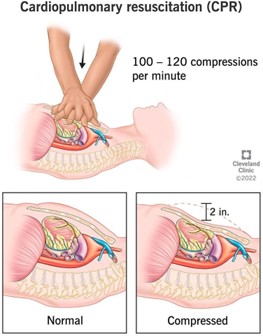RH has a history of COPD. The CNA checks his vital signs at the beginning of the shift and tells you that his pulse ox reading is 91%. What should the nurse advise the CAN does next:
Chart the reading at 91%, this is normal for a COPD patient.
Place a non-rebreather on the patient with high flow oxygen.
Call the doctor if the patient is declining.
Sit the patient up and have them breathe deep.
The Correct Answer is D
Sitting the patient up and encouraging deep breathing can help improve oxygenation and increase the pulse oximetry reading. This is a non-invasive intervention that can be implemented immediately to help improve the patient’s oxygen levels.
Nursing Test Bank
Naxlex Comprehensive Predictor Exams
Related Questions
Correct Answer is C
Explanation
CPR (Cardiopulmonary Resuscitation) is a life-saving procedure that is performed when a person's heart has stopped beating. It involves chest compressions and rescue breathing to restore the circulation of oxygenated blood to the brain and other vital organs. The timely initiation of CPR can significantly increase the chances of a patient's survival.
In a healthcare setting, UAPs/CNAs are often trained to provide basic life support, including initiating CPR, until a healthcare provider arrives. However, giving IV epinephrine, intubating the patient, and obtaining arterial blood gases are all advanced medical procedures that require specialized training and expertise. These actions should only be performed by trained healthcare providers, such as registered nurses, physicians, or respiratory therapists, and cannot be delegated to UAPs/CNAs.

Correct Answer is A
Explanation
In case of suspected ingestion of a poisonous substance, the priority response of the poison control nurse should be to assess the child's vital signs, especially breathing and heart rate, to determine if the child is experiencing any immediate life-threatening symptoms. This information will help the nurse determine the appropriate course of action, such as whether to instruct the caregiver to perform CPR or to immediately call for emergency medical assistance.
Asking about the substance ingested and the time of ingestion are also important pieces of information to gather, but they should not take priority over assessing the child's vital signs. Inducing vomiting is generally not recommended unless instructed to do so by a medical professional, as it can cause further harm if the substance ingested is corrosive or caustic.
Whether you are a student looking to ace your exams or a practicing nurse seeking to enhance your expertise , our nursing education contents will empower you with the confidence and competence to make a difference in the lives of patients and become a respected leader in the healthcare field.
Visit Naxlex, invest in your future and unlock endless possibilities with our unparalleled nursing education contents today
Report Wrong Answer on the Current Question
Do you disagree with the answer? If yes, what is your expected answer? Explain.
Kindly be descriptive with the issue you are facing.
